NUTR73-700: Malnutrition Screening in Cancer Outpatients at MCCC
VerifiedAdded on 2023/06/10
|12
|1073
|238
Presentation
AI Summary
This presentation discusses a malnutrition screening and assessment audit conducted on cancer outpatients receiving day treatment at the Mater Cancer Care Centre (MCCC). The audit utilized the Malnutrition Screening Tool (MST) and the Patient-Generated Subjective Global Assessment (PG-SGA) to identify patients at risk of malnutrition. The study aimed to investigate the prevalence of malnutrition, compare the effectiveness of different screening tools, and determine which patients required dietician intervention. The methodology involved a cross-sectional study design, data collection from the MCCC's yearly audit, and analysis using CFS tables. The results were intended for presentation to MCCC staff, publication as an abstract for conferences, and submission as a research paper. The presentation includes details on the study's background, PICO question, hypothesis, objectives, procedures, and data management strategies.
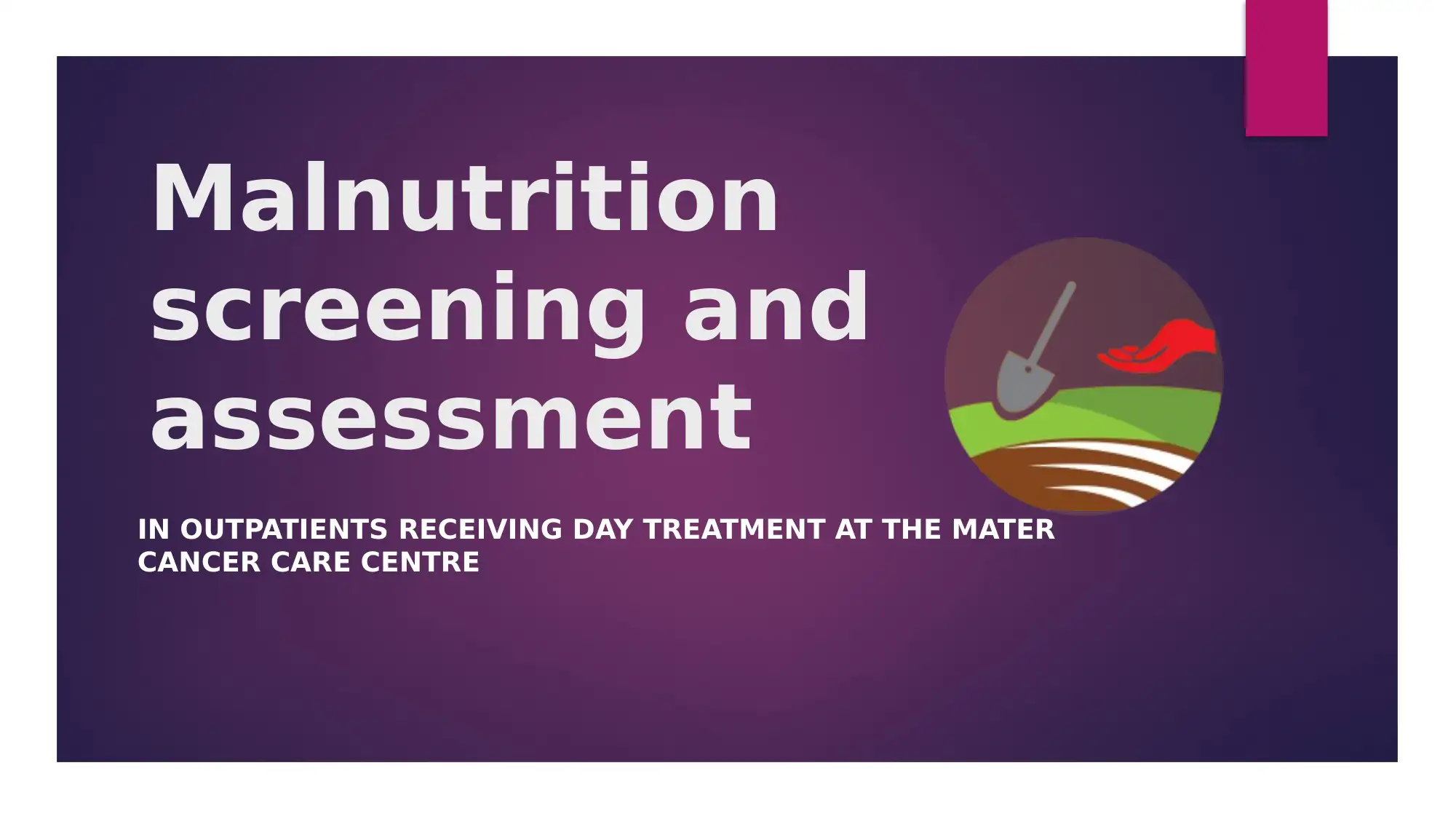
Malnutrition
screening and
assessment
IN OUTPATIENTS RECEIVING DAY TREATMENT AT THE MATER
CANCER CARE CENTRE
screening and
assessment
IN OUTPATIENTS RECEIVING DAY TREATMENT AT THE MATER
CANCER CARE CENTRE
Paraphrase This Document
Need a fresh take? Get an instant paraphrase of this document with our AI Paraphraser
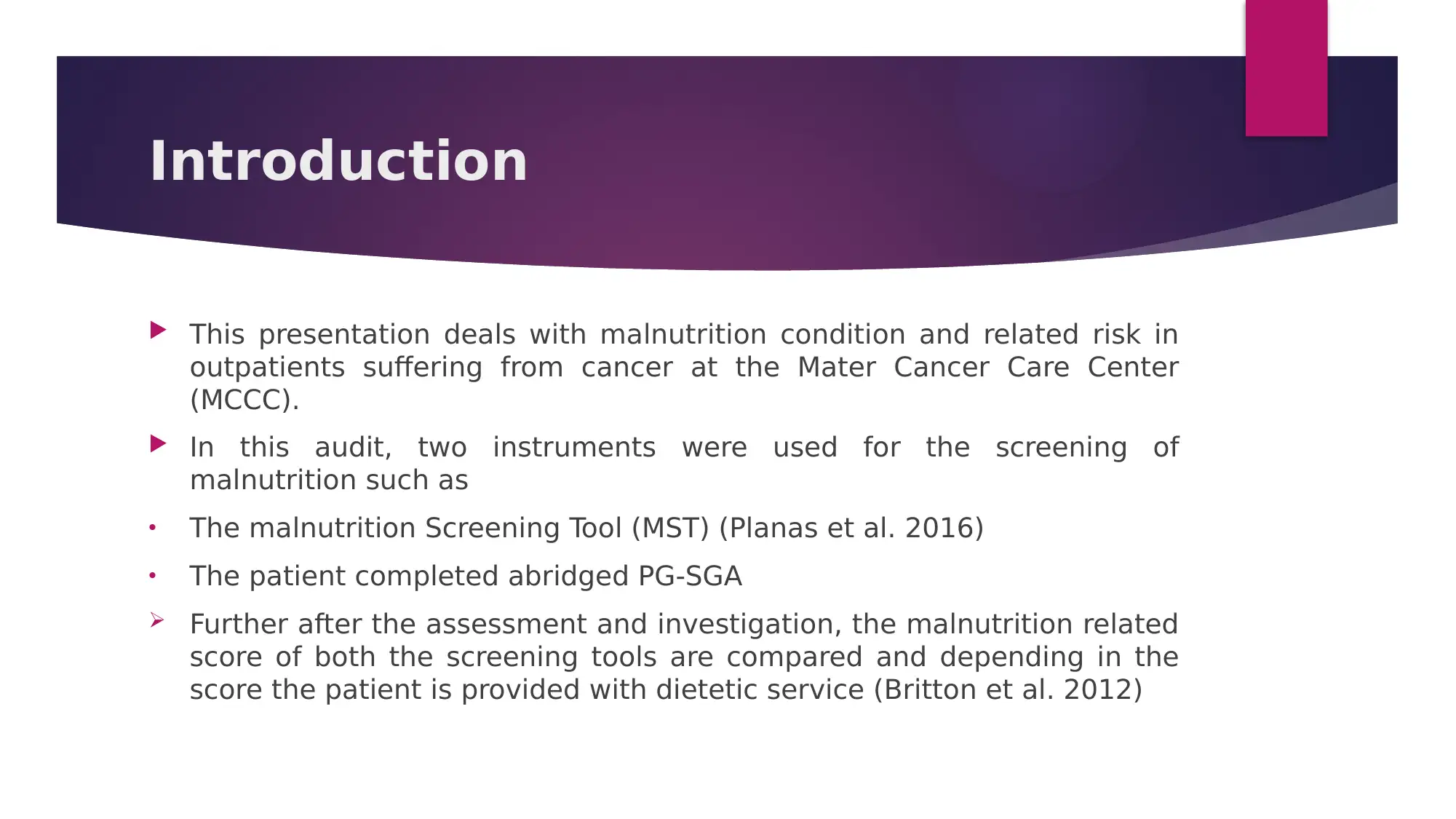
Introduction
This presentation deals with malnutrition condition and related risk in
outpatients suffering from cancer at the Mater Cancer Care Center
(MCCC).
In this audit, two instruments were used for the screening of
malnutrition such as
• The malnutrition Screening Tool (MST) (Planas et al. 2016)
• The patient completed abridged PG-SGA
Further after the assessment and investigation, the malnutrition related
score of both the screening tools are compared and depending in the
score the patient is provided with dietetic service (Britton et al. 2012)
This presentation deals with malnutrition condition and related risk in
outpatients suffering from cancer at the Mater Cancer Care Center
(MCCC).
In this audit, two instruments were used for the screening of
malnutrition such as
• The malnutrition Screening Tool (MST) (Planas et al. 2016)
• The patient completed abridged PG-SGA
Further after the assessment and investigation, the malnutrition related
score of both the screening tools are compared and depending in the
score the patient is provided with dietetic service (Britton et al. 2012)
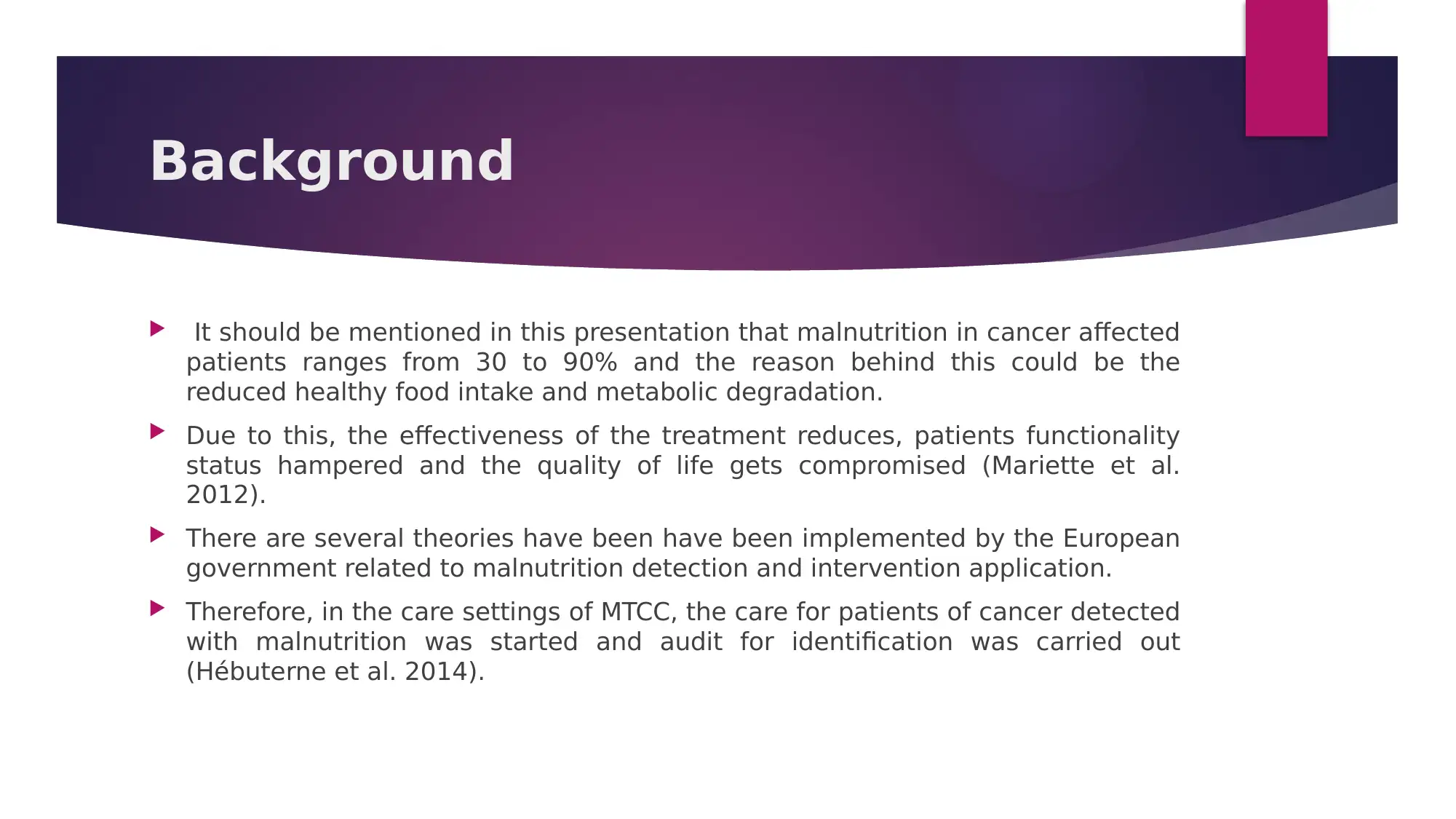
Background
It should be mentioned in this presentation that malnutrition in cancer affected
patients ranges from 30 to 90% and the reason behind this could be the
reduced healthy food intake and metabolic degradation.
Due to this, the effectiveness of the treatment reduces, patients functionality
status hampered and the quality of life gets compromised (Mariette et al.
2012).
There are several theories have been have been implemented by the European
government related to malnutrition detection and intervention application.
Therefore, in the care settings of MTCC, the care for patients of cancer detected
with malnutrition was started and audit for identification was carried out
(Hébuterne et al. 2014).
It should be mentioned in this presentation that malnutrition in cancer affected
patients ranges from 30 to 90% and the reason behind this could be the
reduced healthy food intake and metabolic degradation.
Due to this, the effectiveness of the treatment reduces, patients functionality
status hampered and the quality of life gets compromised (Mariette et al.
2012).
There are several theories have been have been implemented by the European
government related to malnutrition detection and intervention application.
Therefore, in the care settings of MTCC, the care for patients of cancer detected
with malnutrition was started and audit for identification was carried out
(Hébuterne et al. 2014).
⊘ This is a preview!⊘
Do you want full access?
Subscribe today to unlock all pages.

Trusted by 1+ million students worldwide
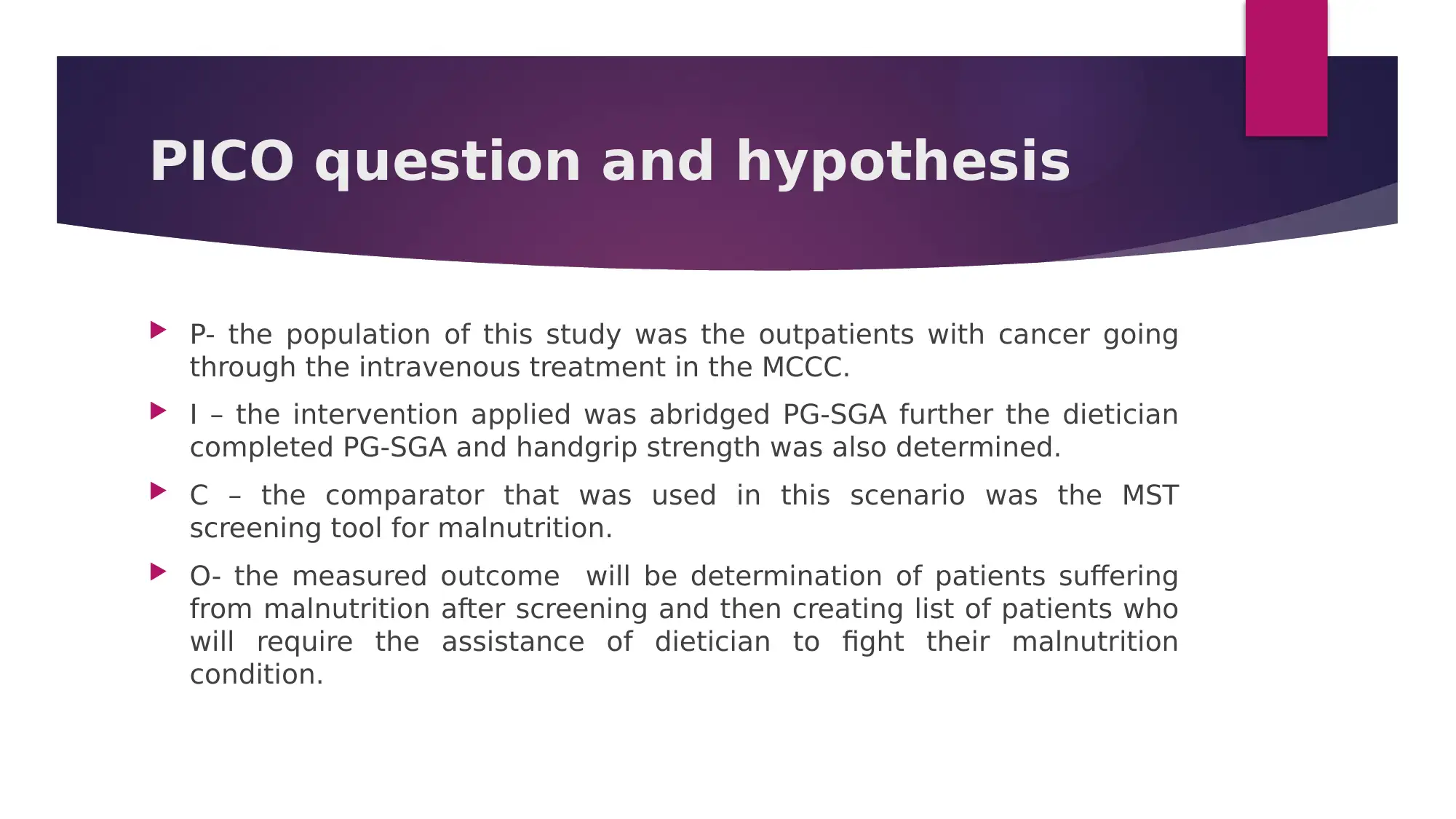
PICO question and hypothesis
P- the population of this study was the outpatients with cancer going
through the intravenous treatment in the MCCC.
I – the intervention applied was abridged PG-SGA further the dietician
completed PG-SGA and handgrip strength was also determined.
C – the comparator that was used in this scenario was the MST
screening tool for malnutrition.
O- the measured outcome will be determination of patients suffering
from malnutrition after screening and then creating list of patients who
will require the assistance of dietician to fight their malnutrition
condition.
P- the population of this study was the outpatients with cancer going
through the intravenous treatment in the MCCC.
I – the intervention applied was abridged PG-SGA further the dietician
completed PG-SGA and handgrip strength was also determined.
C – the comparator that was used in this scenario was the MST
screening tool for malnutrition.
O- the measured outcome will be determination of patients suffering
from malnutrition after screening and then creating list of patients who
will require the assistance of dietician to fight their malnutrition
condition.
Paraphrase This Document
Need a fresh take? Get an instant paraphrase of this document with our AI Paraphraser
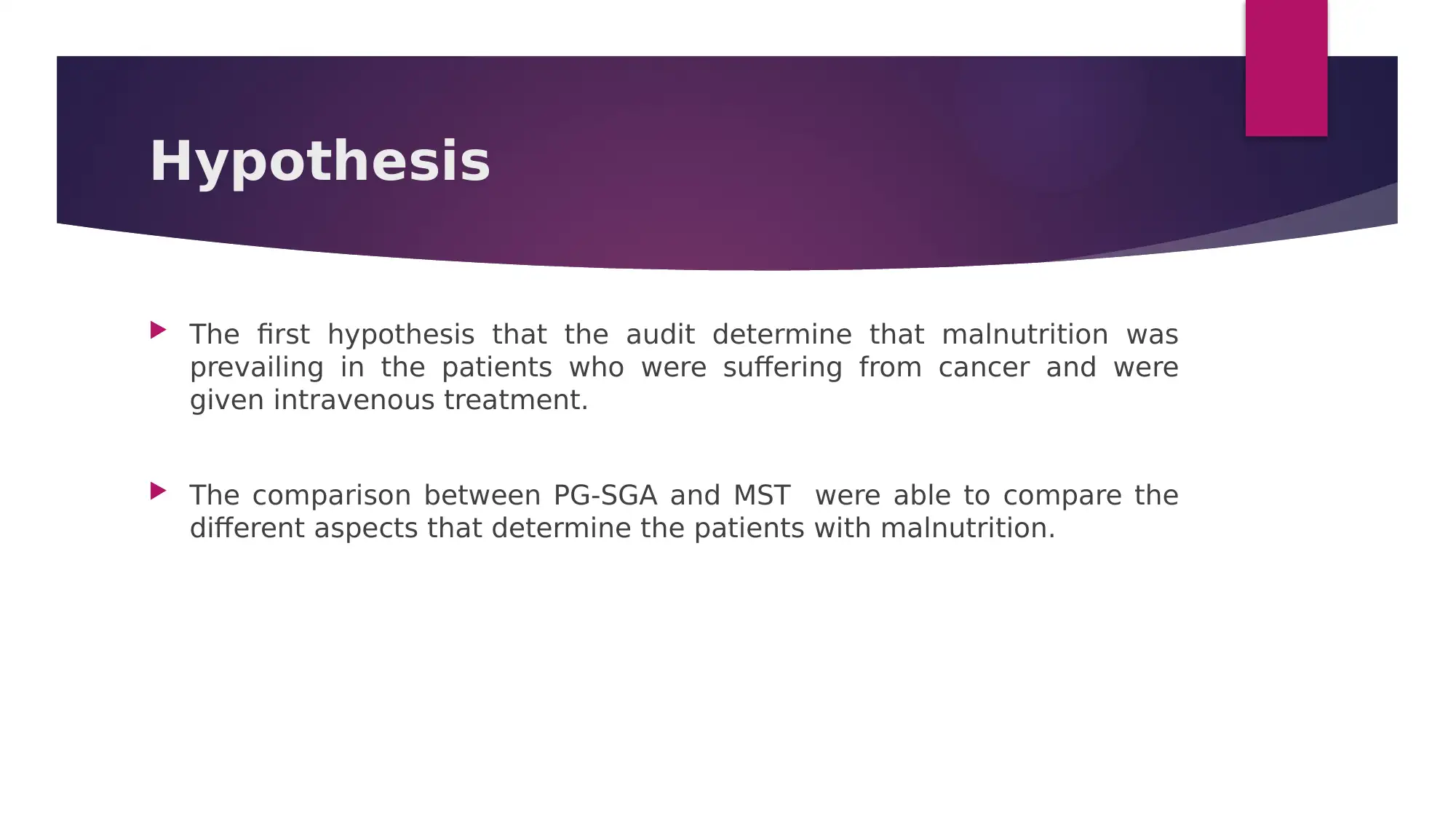
Hypothesis
The first hypothesis that the audit determine that malnutrition was
prevailing in the patients who were suffering from cancer and were
given intravenous treatment.
The comparison between PG-SGA and MST were able to compare the
different aspects that determine the patients with malnutrition.
The first hypothesis that the audit determine that malnutrition was
prevailing in the patients who were suffering from cancer and were
given intravenous treatment.
The comparison between PG-SGA and MST were able to compare the
different aspects that determine the patients with malnutrition.
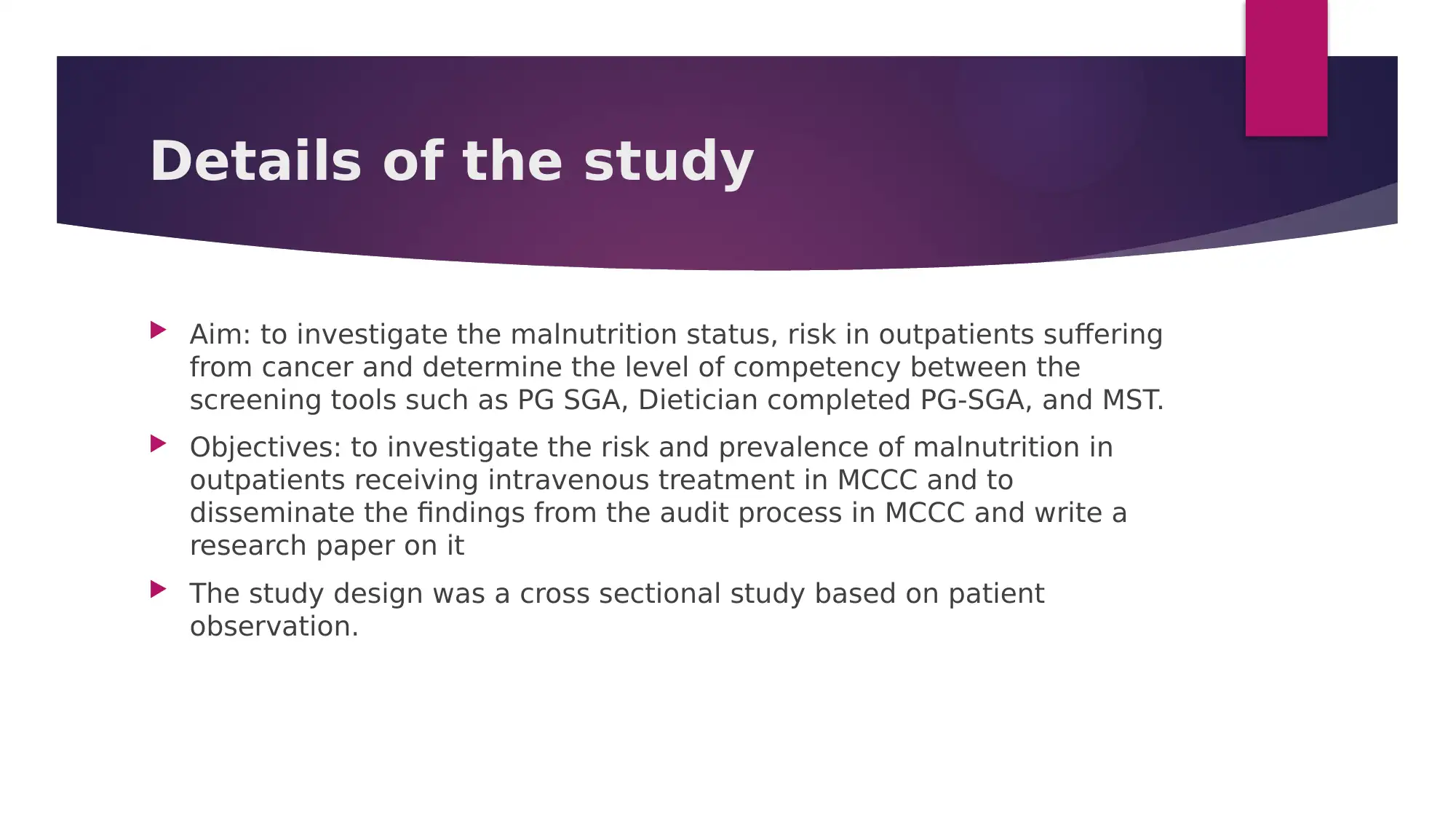
Details of the study
Aim: to investigate the malnutrition status, risk in outpatients suffering
from cancer and determine the level of competency between the
screening tools such as PG SGA, Dietician completed PG-SGA, and MST.
Objectives: to investigate the risk and prevalence of malnutrition in
outpatients receiving intravenous treatment in MCCC and to
disseminate the findings from the audit process in MCCC and write a
research paper on it
The study design was a cross sectional study based on patient
observation.
Aim: to investigate the malnutrition status, risk in outpatients suffering
from cancer and determine the level of competency between the
screening tools such as PG SGA, Dietician completed PG-SGA, and MST.
Objectives: to investigate the risk and prevalence of malnutrition in
outpatients receiving intravenous treatment in MCCC and to
disseminate the findings from the audit process in MCCC and write a
research paper on it
The study design was a cross sectional study based on patient
observation.
⊘ This is a preview!⊘
Do you want full access?
Subscribe today to unlock all pages.

Trusted by 1+ million students worldwide
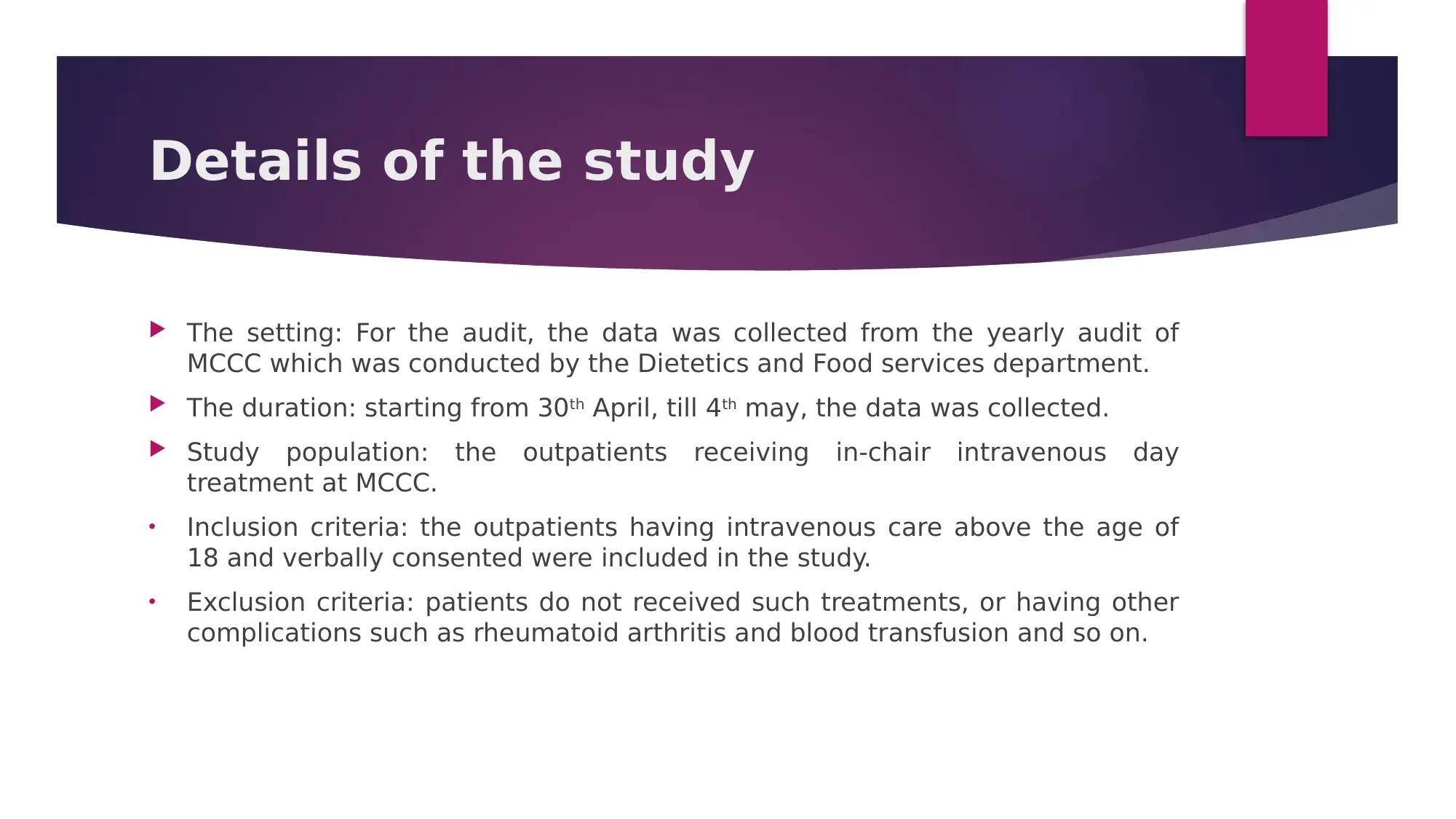
Details of the study
The setting: For the audit, the data was collected from the yearly audit of
MCCC which was conducted by the Dietetics and Food services department.
The duration: starting from 30th April, till 4th may, the data was collected.
Study population: the outpatients receiving in-chair intravenous day
treatment at MCCC.
• Inclusion criteria: the outpatients having intravenous care above the age of
18 and verbally consented were included in the study.
• Exclusion criteria: patients do not received such treatments, or having other
complications such as rheumatoid arthritis and blood transfusion and so on.
The setting: For the audit, the data was collected from the yearly audit of
MCCC which was conducted by the Dietetics and Food services department.
The duration: starting from 30th April, till 4th may, the data was collected.
Study population: the outpatients receiving in-chair intravenous day
treatment at MCCC.
• Inclusion criteria: the outpatients having intravenous care above the age of
18 and verbally consented were included in the study.
• Exclusion criteria: patients do not received such treatments, or having other
complications such as rheumatoid arthritis and blood transfusion and so on.
Paraphrase This Document
Need a fresh take? Get an instant paraphrase of this document with our AI Paraphraser
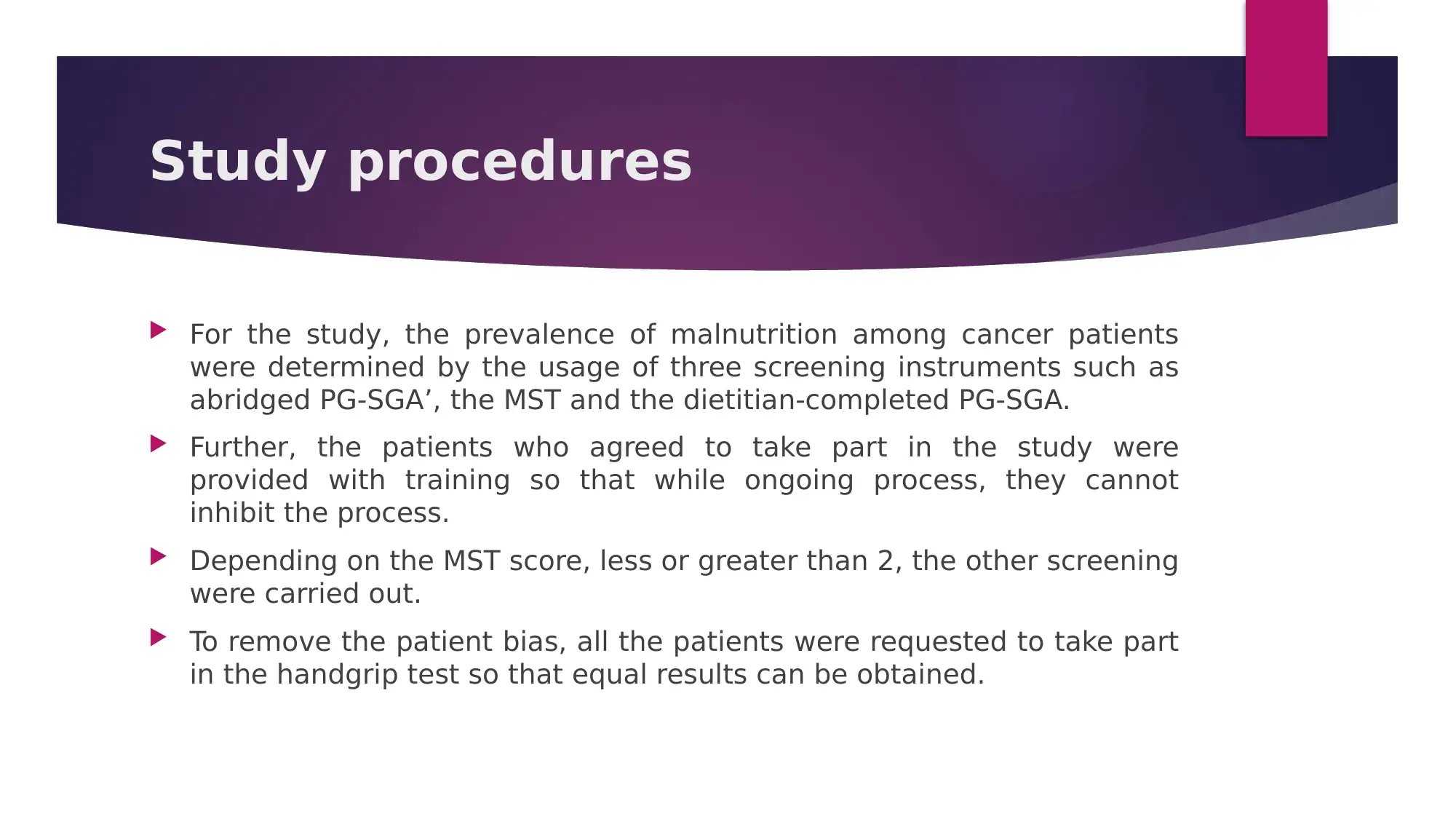
Study procedures
For the study, the prevalence of malnutrition among cancer patients
were determined by the usage of three screening instruments such as
abridged PG-SGA’, the MST and the dietitian-completed PG-SGA.
Further, the patients who agreed to take part in the study were
provided with training so that while ongoing process, they cannot
inhibit the process.
Depending on the MST score, less or greater than 2, the other screening
were carried out.
To remove the patient bias, all the patients were requested to take part
in the handgrip test so that equal results can be obtained.
For the study, the prevalence of malnutrition among cancer patients
were determined by the usage of three screening instruments such as
abridged PG-SGA’, the MST and the dietitian-completed PG-SGA.
Further, the patients who agreed to take part in the study were
provided with training so that while ongoing process, they cannot
inhibit the process.
Depending on the MST score, less or greater than 2, the other screening
were carried out.
To remove the patient bias, all the patients were requested to take part
in the handgrip test so that equal results can be obtained.
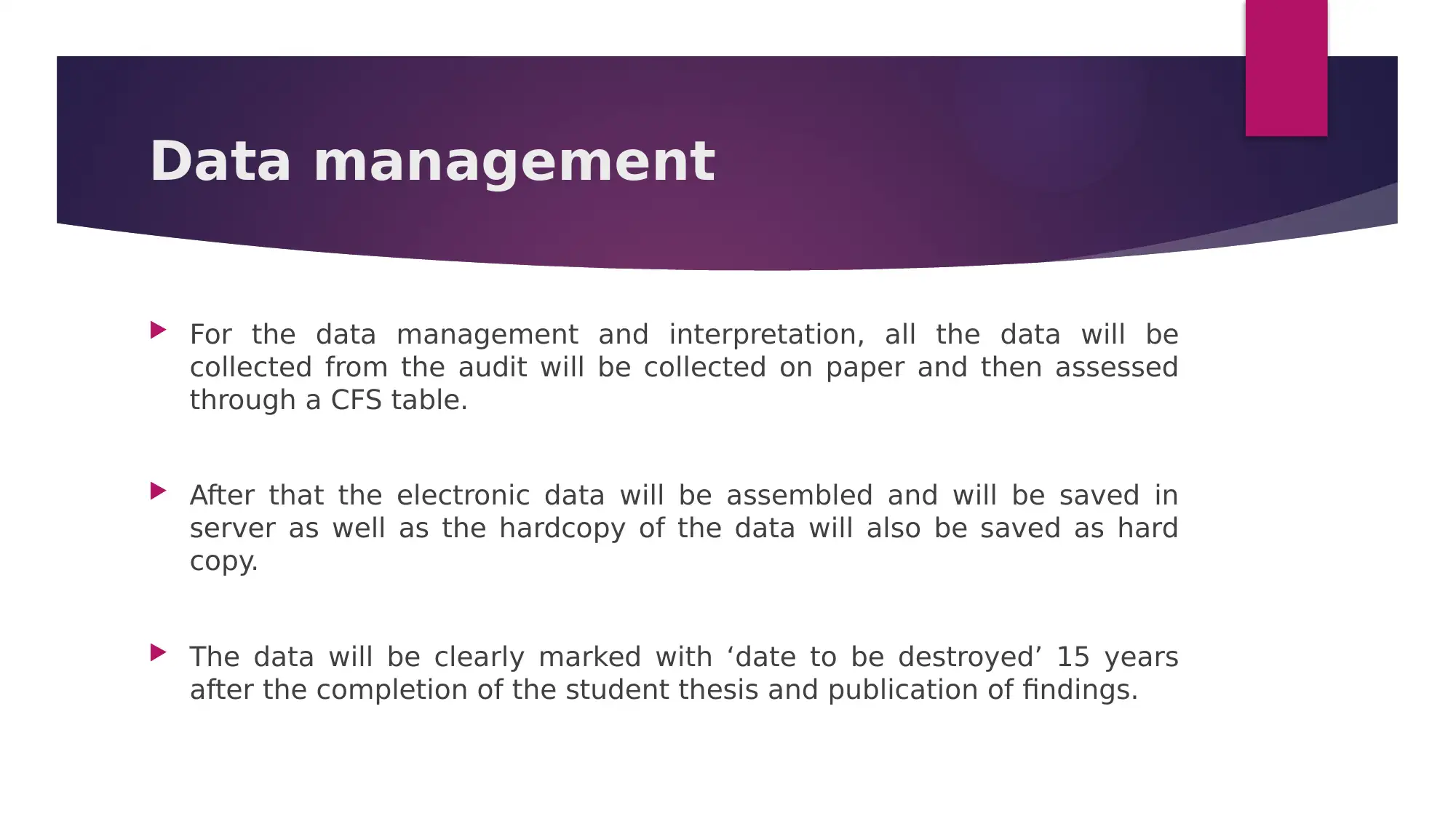
Data management
For the data management and interpretation, all the data will be
collected from the audit will be collected on paper and then assessed
through a CFS table.
After that the electronic data will be assembled and will be saved in
server as well as the hardcopy of the data will also be saved as hard
copy.
The data will be clearly marked with ‘date to be destroyed’ 15 years
after the completion of the student thesis and publication of findings.
For the data management and interpretation, all the data will be
collected from the audit will be collected on paper and then assessed
through a CFS table.
After that the electronic data will be assembled and will be saved in
server as well as the hardcopy of the data will also be saved as hard
copy.
The data will be clearly marked with ‘date to be destroyed’ 15 years
after the completion of the student thesis and publication of findings.
⊘ This is a preview!⊘
Do you want full access?
Subscribe today to unlock all pages.

Trusted by 1+ million students worldwide
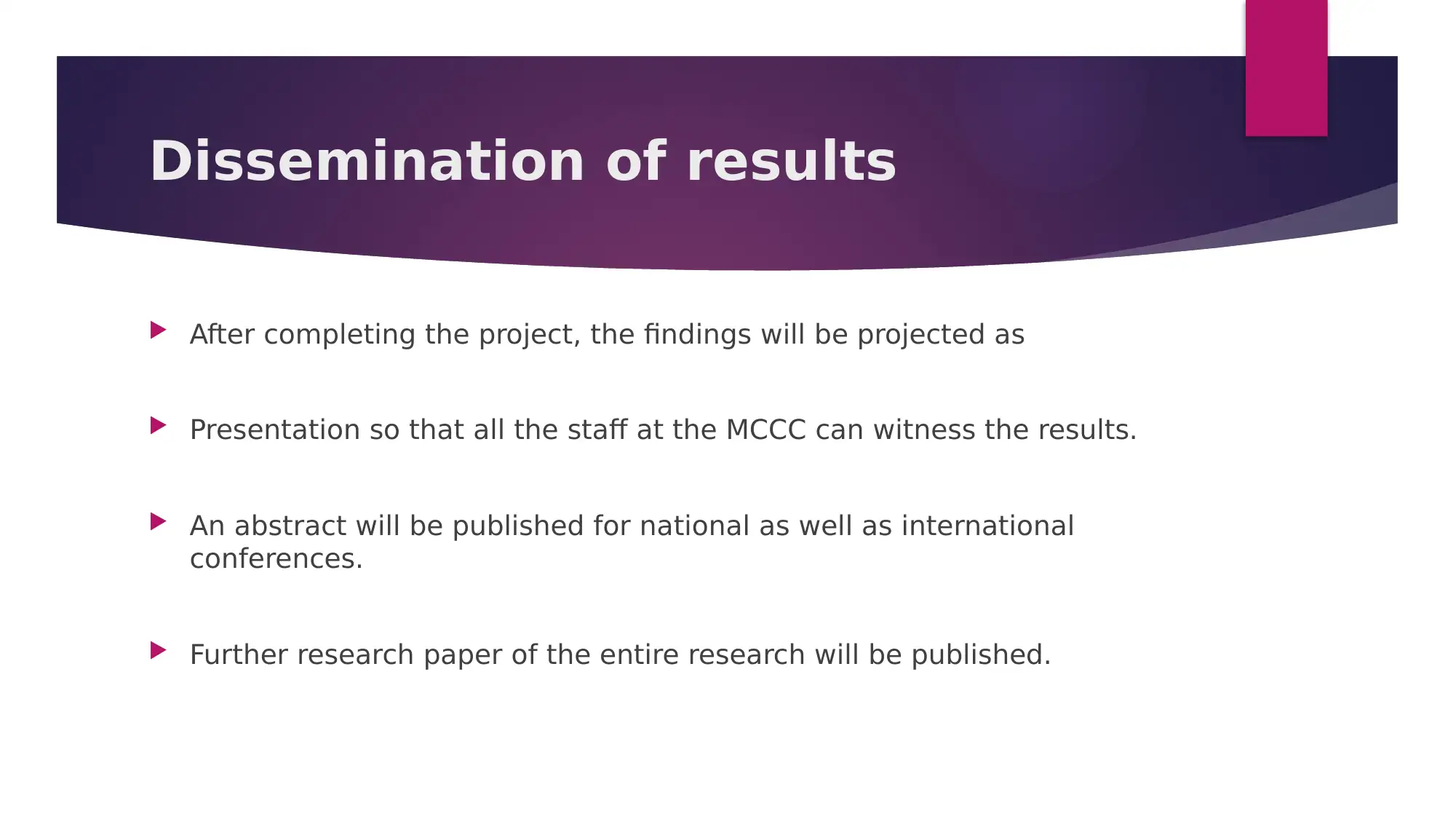
Dissemination of results
After completing the project, the findings will be projected as
Presentation so that all the staff at the MCCC can witness the results.
An abstract will be published for national as well as international
conferences.
Further research paper of the entire research will be published.
After completing the project, the findings will be projected as
Presentation so that all the staff at the MCCC can witness the results.
An abstract will be published for national as well as international
conferences.
Further research paper of the entire research will be published.
Paraphrase This Document
Need a fresh take? Get an instant paraphrase of this document with our AI Paraphraser
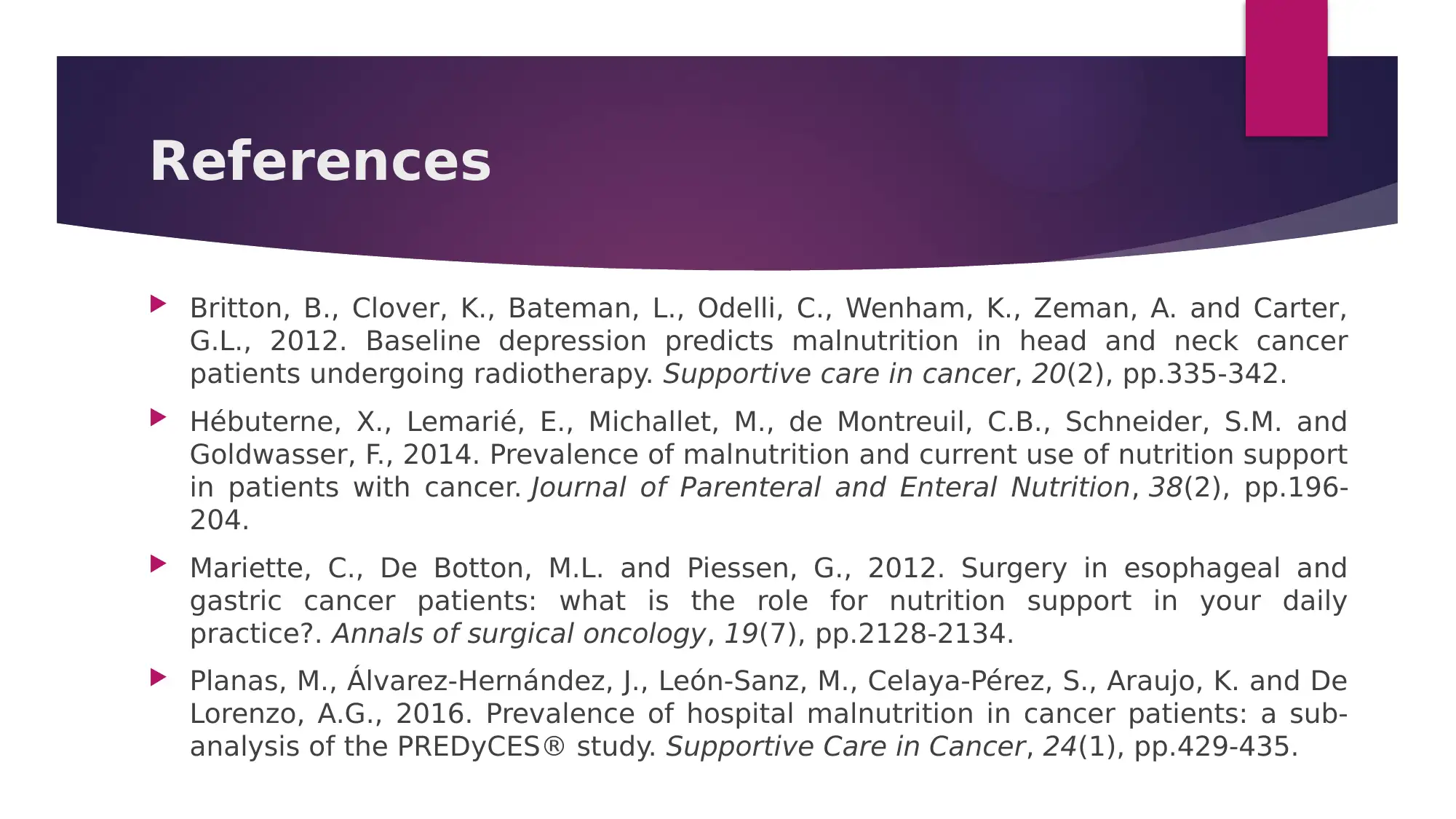
References
Britton, B., Clover, K., Bateman, L., Odelli, C., Wenham, K., Zeman, A. and Carter,
G.L., 2012. Baseline depression predicts malnutrition in head and neck cancer
patients undergoing radiotherapy. Supportive care in cancer, 20(2), pp.335-342.
Hébuterne, X., Lemarié, E., Michallet, M., de Montreuil, C.B., Schneider, S.M. and
Goldwasser, F., 2014. Prevalence of malnutrition and current use of nutrition support
in patients with cancer. Journal of Parenteral and Enteral Nutrition, 38(2), pp.196-
204.
Mariette, C., De Botton, M.L. and Piessen, G., 2012. Surgery in esophageal and
gastric cancer patients: what is the role for nutrition support in your daily
practice?. Annals of surgical oncology, 19(7), pp.2128-2134.
Planas, M., Álvarez-Hernández, J., León-Sanz, M., Celaya-Pérez, S., Araujo, K. and De
Lorenzo, A.G., 2016. Prevalence of hospital malnutrition in cancer patients: a sub-
analysis of the PREDyCES® study. Supportive Care in Cancer, 24(1), pp.429-435.
Britton, B., Clover, K., Bateman, L., Odelli, C., Wenham, K., Zeman, A. and Carter,
G.L., 2012. Baseline depression predicts malnutrition in head and neck cancer
patients undergoing radiotherapy. Supportive care in cancer, 20(2), pp.335-342.
Hébuterne, X., Lemarié, E., Michallet, M., de Montreuil, C.B., Schneider, S.M. and
Goldwasser, F., 2014. Prevalence of malnutrition and current use of nutrition support
in patients with cancer. Journal of Parenteral and Enteral Nutrition, 38(2), pp.196-
204.
Mariette, C., De Botton, M.L. and Piessen, G., 2012. Surgery in esophageal and
gastric cancer patients: what is the role for nutrition support in your daily
practice?. Annals of surgical oncology, 19(7), pp.2128-2134.
Planas, M., Álvarez-Hernández, J., León-Sanz, M., Celaya-Pérez, S., Araujo, K. and De
Lorenzo, A.G., 2016. Prevalence of hospital malnutrition in cancer patients: a sub-
analysis of the PREDyCES® study. Supportive Care in Cancer, 24(1), pp.429-435.

⊘ This is a preview!⊘
Do you want full access?
Subscribe today to unlock all pages.

Trusted by 1+ million students worldwide
1 out of 12
Related Documents
Your All-in-One AI-Powered Toolkit for Academic Success.
+13062052269
info@desklib.com
Available 24*7 on WhatsApp / Email
![[object Object]](/_next/static/media/star-bottom.7253800d.svg)
Unlock your academic potential
Copyright © 2020–2025 A2Z Services. All Rights Reserved. Developed and managed by ZUCOL.



